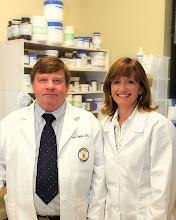Friday, September 25, 2009
Hyperpigmentation
One example of hyperpigmentation is called melasma, also known as chloasma, which is characterized by brown patches usually occuring on the forehead, temples, and cheeks. Melasma can occur in pregnant women and in women who are taking oral contraceptives and is sometimes called the "mask of pregnancy", but it can occur in men as well. Melasma is more common and lasts longer in people with dark skin. Another example of hyperpigmentation is lentigines which are also called "liver spots" and they typically occur on the face and back of the hands. Lentigines are flat brown spots that are oval in shape. Chronic sun exposure is the major cause of solar lentigines. Middle age is typically the first time lentigines are noticed and they increase in number with age. Lentigines are an independent risk factor for melanoma even though a progression from lentigines to melanoma has not been established.
The topical treatments for hyperpigmentation consist mostly of chemicals that inhibit the enzyme tyrosinase, which forms pigment. Some of these chemicals used to treat hyperpigmentation are hydroquinone, kojic acid, vitamin C, azelaic acid, and arbutin. Hydroquinone has been under scrutiny for its mutagenic effect and its ability to darken the skin after prolonged use. It is banned in Japan and the European Union. Kojic acid was discovered by accident when scientists in Japan were fermenting malted rice to make sake and kojic acid was a by-product. Azelaic acid which is found in wheat and barley is a weak inhibitor of tyrosinase so a high concentration, such as 15%, is needed to produce lightening. Arbutin is purified from mulberry or bearberry extract and is almost chemically identical to hydroquinone with the addition of a sugar molecule. Once it comes in contact with the skin the sugar is cleaved and hydroquinone is slowly released. Arbutin takes a few weeks longer to work than hydroquinone, but it causes less irritation. Vitamin A derivatives such as retinol, alpha hydroxy acids, and beta hydroxy acids are often used in conjunction with lighteners because they increase skin cell turnover which in turn speeds the removal of pigment granules. Niacinamide is also an effective skin lightener. Its mechanism of action is unrelated to the enzyme tyrosinase. Niacinamide prohibits the transfer of melanosomes (the pigment containing organelle) to skin cells inhibiting the production of discolored cells.
All of these treatments require two to three months before results can be seen so patience is needed. Your expectations should be reasonable since these products will lighten but not erase the spots. They are most effective in light skinned people. Lighteners can make the skin more sensitive to the sun so a sunscreen is required while using skin lightening products. Sunscreens are the first defense against skin aging in general, but particularly to prevent hyperpigmentation so start using sunscreens today to protect your skin for tomorrow.
Thursday, September 17, 2009
The Science of Aging Skin
Using products that contain the most effective ingredients such as glycolic acid, retinol, peptides, and vitamin c among others is the best tool in fighting the aging process. Combining effective products with professional facial care will generate the best benefits for your skin as you age. It is never too late to start a skin care program, but the earlier you start the better your skin will age. Start today making favorable lifestyle choices combined with high quality products and your skin will benefit.
Thursday, September 3, 2009
Cellulite
The skin is connected to the underlying muscle by fibrous cords. These cords connect the skin to deeper structures with the fat cells lying in between . The cords pull the skin down, but as the fat cells accumulate they push up against the skin creating the dimpling effect seen as cellulite. It is commonly seen in families so a strong genetic component is definitely a contributing factor for developing cellulite. Even though weight is not necessarily a factor in cellulite development, maintaining a normal weight will decrease the appearance of cellulite. Also, increasing muscle tone will lessen the appearance of cellulite as well. Liposuction is not an alternative for cellulite treatment and may actually increase its appearance. According to a study recently published in the Aesthetic Surgery Journal, cellulite may be improved with a combination of laser treatment and fat transplantation. Laser treatment on the affected area proved to tighten the skin by stimulating collagen production and on a deeper level the laser proved to reduce fatty tissue. The fat from the patient was transplanted by injection into the dimpled areas to plump the skin. This was a small study, but had promising results. More research will be performed to obtain final conclusions. Unfortunately, there are not really any effective topical treatments for reducing cellulite. The best treatments contain collagen building ingredients such as Retinol and Vitamin C, but it takes several weeks to see any benefit from these products. Much research is being done in the cellulite fight so keep informed for the latest innovations. Since the public is clamoring for an effective cellulite treatment, researchers are bound to find something to alleviate this unsightly condition.

